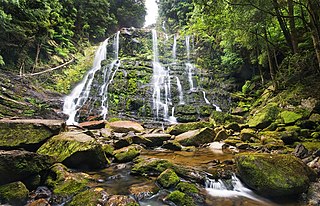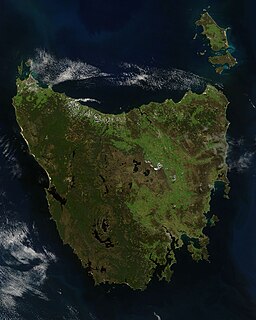This page is based on this
Wikipedia article Text is available under the
CC BY-SA 4.0 license; additional terms may apply.
Images, videos and audio are available under their respective licenses.

Franklin-Gordon Wild Rivers is a national park in Tasmania, 117 km west of Hobart. It is named after the two main river systems lying within the bounds of the park - the Franklin River and the Gordon River.

The Tasmanian temperate rain forests are part of the Australasia ecozone, which includes Tasmania and Australia, New Zealand, New Guinea, New Caledonia, and adjacent islands.

The Macquarie Harbour Penal Station, a former British colonial penal settlement, established on Sarah Island, Macquarie Harbour, in the former colony of Van Diemen's Land, now Tasmania, operated between 1822 and 1833. The settlement housed mainly male convicts, with a small number of women. During its 11 years of operation, the penal colony achieved a reputation as one of the harshest penal settlements in the Australian colonies. The formal penal station is located on the eight-hectare (twenty-acre) Sarah Island that now operates as an historic site under the direction of the Tasmania Parks and Wildlife Service.

The West Coast of Tasmania has a significant convict heritage. The use of the West Coast as an outpost to house convicts in isolated penal settlements occurred in the eras 1822–33, and 1846–47.

The West Coast of Tasmania is the part of the state that is strongly associated with wilderness, mining and tourism, rough country and isolation. As well as that, it was an early convict settlement location in the early stages of Van Diemen's Land.

The Montezuma Falls, a horsetail waterfall on a minor tributary to the Pieman River, is located on the West Coast Range of Tasmania, Australia.
Thomas Bather Moore was a pioneer explorer of Western and South West, Tasmania, Australia.

Mount Murchison is a mountain on the West Coast Range, located in the West Coast region of Tasmania, Australia.
Tasmania, given its small geographic size and population has a flourishing literary culture. Historically Tasmania provides a fascinating literary background with visits from early European explorers such as the Dutchman Abel Tasman, the Frenchmen Bruni d'Entrecasteaux and Marion du Fresne and then the English explorers Matthew Flinders and George Bass. The colonisation of Tasmania was characterised by deteriorated relations with the indigenous Aboriginal people and a harsh convict heritage. These early elements of Tasmanian history are found both in the large number of colonial sandstone buildings and in the place names. Environmentally, Tasmania's picturesque landscapes and changeable weather, provide a vivid backdrop to Tasmanian literary culture. Tasmania's geographical isolation, rich creative community, proximity to Antarctica, controversial colonial past, bourgeoning reputation as a dynamic centre for the arts, and status as an island state, are some of the influences found in the island's significant collection of literature.
Arthurs galaxias is a species of fish in the Galaxiidae family. It is endemic to Tasmania in Australia.
The South West Book - A Tasmanian Wilderness is a book published by the Australian Conservation Foundation in 1978 during concern following the damming of Lake Pedder in Tasmania.
The Lake Pedder Action Committee was a Tasmanian environmental group.
Historical bibliographies of Tasmania were a series of books produced by the Centre of Tasmanian Historical Studies and the History Department of the University of Tasmania.
Tasmania's offshore islands: seabirds and other natural features is a book published by the Tasmanian Museum and Art Gallery in 2001. The book is considered an essential measure of the state of Tasmania's islands, birds inhabiting them, and the condition of the islands. The main author was Nigel Brothers, a Hobart based biologist, the other contributors were Vanessa Halley, Helen Pryor, and David Pemberton.
The Tasmanian archipelago is made up of 334 islands. This book highlights the uniqueness and importance of 280, as significant breeding refuges and wealthy natural resources. Islands are documented with descriptions of topography, wildlife, vegetation and full-colour photographs."
South West Tasmania Resources Survey was a government funded and based project in Tasmania to collect and appraise information about the South West Tasmania region in a systematic manner.
C.J. Binks is a Tasmanian writer.
Helen Gee was an Australian author, editor, conservationist and environmental activist.
South West Tasmania Action Committee was a group started after the flooding of the lake in South West Tasmania known as Lake Pedder to create the Gordon Dam catchment.
The Tasmanian Environment Centre was an environment centre in Hobart in Tasmania between 1970s and 2000s.
As of 2018, several firms in the United States rank among the world's biggest publishers of books in terms of revenue: Cengage Learning, HarperCollins, Houghton Mifflin Harcourt, McGraw-Hill Education, Scholastic, Simon & Schuster, and Wiley.









